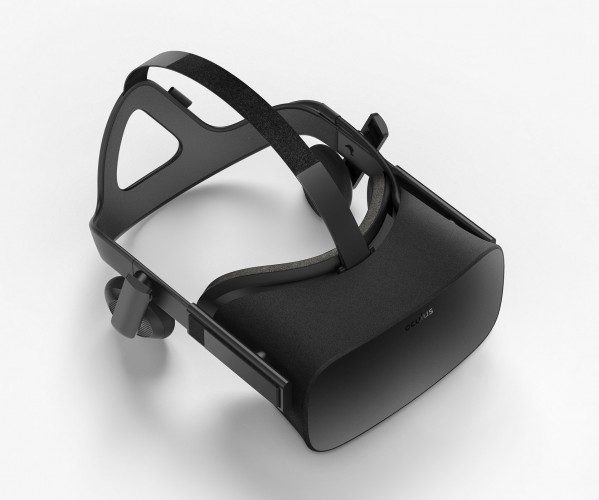There’s been some commotion about the price of the new Oculus Rift pre-order bundle, and although nearly doubling the infamous ‘$350 ballpark’ estimate given out by company founder Palmer Luckey (for which he apologized), we thought this quick high-level breakdown might help clarify what you’re getting for hard earned cash.
Headset, Optics, and Display
Making things comfortable is important, and Oculus has focused their resources on improving the headset’s overall balance and stability, choosing to evolve the front-heavy ski goggle design seen in both previous developer kits.
The headset is light, and having now had the chance to wear CV1 engineering samples for 20-30 mins at a time, it’s easy to see multi-hour gameplay passing with little complaint. There is no active ventilation present on the headset however.


Although we’re waiting on an iFixit breakdown of the entire system when it arrives to consumers in late March, Oculus says that the headset is sporting two built-for-VR Samsung OLED displays with a 1080 × 1200 per-eye resolution – 90Hz global refresh pushing 233 million pixels per second. Displays are specially treated to reduce perceived screen door effect, or the visible spaces between pixels. If you’ve used the Rift DK1 or DK2, you’ll be surprised at how diminished the screen door effect has become.
On the underside of the headset, is a small slider, designed to shift lenses and displays to match the unique distance between your pupils, crucial for a comfortable VR experience. IPD range hasn’t been officially confirmed, but should be good for all but 5% of the population with either extremely low or high IPDs.
Founder Palmer Luckey says the custom hybrid Fresnel lenses used in the headset are “more complex to manufacture than many high end DSLR lenses.” Luckey also told us in an interview that they’ve “managed to push optics technology pretty far to make that happen.”
See Also: Oculus Rift Pre-Order ETA is Now June for New Orders
High-End Integrated Audio
The integrated headphones are designed by Carbon, the same industrial design house responsible for the original Xbox controller, so they know a thing or two about ergonomics.
Having a light, well-fitting integrated solution means no added weight pressing down on top of your head, and certainly no more 2-step ‘put on the headset, then put on the headphones’ song and dance. Again, this is something that helps keep you in the the VR experience, and not subconsciously blocking out any discomfort. Both headphones can be removed however, but we’re betting most people will opt to use them based on convenience factor alone.
In line with Oculus’ belief (and their founder’s audiophile roots), the company have incorporated a custom in line DAC (Digital to Analog Converter) and amplifier, designed to deliver what Oculus claims is the cleanest, flattest response from the audio hardware pipeline as possible.
In a hands-on focusing on audio, editor Paul James found the Rift’s headphones to be “clear, crisp and transparent. It seems to me that the drivers found on the Rift are designed for purity and transparency – i.e. reproducing audio frequencies as accurately as possible avoiding colouration or added ‘character’ introduced by the hardware.”
An integrated microphone on the headset guarantees a uniform audio experience when it comes to voice comms in virtual reality. No specs have been released yet on the Rift’s microphone.
IR Tracking Sensor and ‘Constellation’ Array
Constellation is the name, and tracking headsets (and the recently delayed Oculus Touch) is the game.
Facing away from the tracking sensor in a DK2 means one thing: breaking positional tracking. Oculus’ new 360 Constellation Tracking System has set to correct this by providing tracking LEDs not only on the front and side of the headset, but also in the back so that you can turn around without fear of obscuring any part of the headset from the supplied tracking sensor.
Of course, Constellation would be a useless clump of pulsing IR LEDs without a sensor to capture them, so Oculus is including a sleek-looking device designed specifically for the task. With a wide FOV that gives you a reasonably large tracking area (decidedly less than two HTC Vive Lighthouse trackers can provide) to stand up in, the tracking sensor can be mounted practically anywhere due to the sensor’s 1/4 20 mount—the same as most tripods.
Oculus will also be selling IR tracking sensors both as a part of Touch, and on an individual basis so you can extend tracking to any devices that include it’s own constellation tracking array. Limits on this are unknown, how many individual devices that can be tracked individually may have more to do with processing time to calculate each devices’ constellation, but it’s extremely unlikely any user would hit these theoretical limits anyway.


